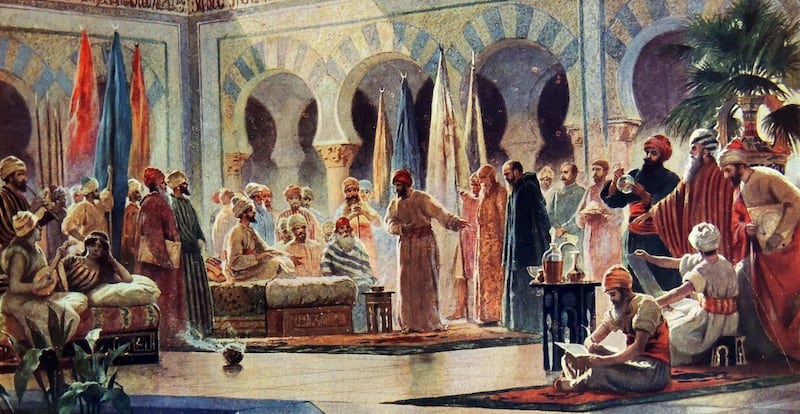Western commentators frequently search for a root cause for the problems of the Middle East to explain everything to their audiences back home. Their latest explanation is the Sunni-Shiite divide, which they like to think fits the bill neatly.
Within a quarter of a century of the death of the Prophet Mohammed in 632, wars over the leadership of the community had begun and many of the leading protagonists who took up arms against each other were people who had known him well and loved him.
The followers of his cousin and son-in-law, Ali, and his descendants eventually became known as Shiites. At the time, Ali's supporters were often at odds with other important companions of the Prophet (such as Talha ibn Ubaydullah and Zubair ibn Al Awam) and then with Muawiya bin Abi Sufian, the founder of the Umayyad caliphate.
In time, those who lived under the Umayyads and then the Abbasids from 750 onwards became considered Sunnis.
This story of battles, religious fervour, heroism and the desire for power and booty makes for exciting reading. It is also essential background to understanding how the Sunni-Shiite split began. Given today's bloodshed in Syria and Iraq, in which sectarianism has come to play a significant role, it can sometimes seem to outside observers that Sunnis and Shiites have always been at war.
________________________
Read more
[ Prominent Iraqi Shiite clerics move out of Iran's shadow ]
[ Saudi cleric's sectarian tweet about late Shiite Kuwait actor sparks debate ]
[ Why time was right for Iraq and Saudi Arabia to focus on common enemies ]
[ Afghanistan: Murder at the mosque as worshippers prayed ]
________________________
Yet we must not mislead ourselves into believing that ancient conflicts have continued to this day. The dynastic disputes between the descendants of Ali and caliphates of Islamic empire ceased to be an existential political issue 800 years ago.
By then, Sunnis and Shiites had crystallised into sects. Yes, each follows different methodologies to discern its teachings, but they share far more than divides them. They also intertwine and overlap.
In the eighth century, Jaafar Al Sadiq, revered by Shiites as the sixth of 12 imams whom they consider to be spiritual and physical successors to the Prophet, taught Malik bin Anas and Abu Hanifa, the founders of two of Sunni Islam's four major law schools. Jaafar is, therefore, also revered within the Sunni school of thought.
In the sixteenth and seventeenth centuries, Europe's Catholic and Protestant rulers were at each other's throats. The same could be said to have been the case with the rivalry between the Sunni Ottomans of Turkey and the Safavids, who had converted Iran to Shi'ism. Yet, as in Europe, the religious element that once stoked war faded away.
In the Middle East, it disappeared at the time of Nadir Shah, who took over the Safavid Empire in the 1730s and had an interest in persuading his Sunni and Shiite soldiers to fight under the same banner. By the late 19th century, Jamal Al Din Al Afghani, the father of Islamic modernism, was downplaying the differences between the sects and trying to bring Muslims together to revive Islam and resist Western imperialism. In the twentieth century, nationalist movements in many Muslim countries followed that path.
So why has the split become so toxic in recent decades? The reason is that politics have once again become intermingled with religion, giving an opening to sectarian purists.
________________________
More on sectarianism in Opinion
[ A centuries-old mistrust is at the heart of Sunni-Shia tension ]
[ The rise of Shia jihadism in Syria will fuel sectarian fires ]
[ Fighting sectarianism is about more than just countering Iran ]
[ A war with Hizbollah would essentially mean war with Iran this time around ]
________________________
Regional rivals have set out to extend their influence and their patronage among Sunni and Shiite communities in states that are weak (as in the case of Pakistan) or are in danger of failing (Iraq since 2003, Syria since 2011). Consequently, Sunnis and Shiites have often been forced to retreat into their shells and sectarian violence has sometimes become endemic.
Yet if we stand back from the bloodshed and the hate, there are other developments occurring that receive less attention. The central question for any religion in the modern world is how to express its values in a way appropriate to rapidly changing times. Building identity politics on the basis of sectarian differences and turning sects into quasi-tribes will only hinder attempts to do this. In fact, it will ultimately discredit religion. There are signs of this happening.
On both sides of the Sunni-Shiite divide, there are many people struggling to build democratic societies in their countries. It is when hereditary rulers and populist governments manipulate sectarian strains for their own ends that hatred is sown.
What is most destructive is when a sectarian element enters into the dissemination of state patronage. It is no accident that the worst sectarian hatred today is arguably in two Arab countries with deeply entrenched secular traditions, Iraq and Syria.
Under the police states of the Al Assads, for example, jobs in the brutal security services went disproportionately to members of the religious minority from which the president came. This caused resentment among the majority of the population. The absence of democracy ensured that the voices of sectarianism would be given the chance to become a galvanising force among the excluded. This should provide us with a pause for reflection.
John McHugo is an honorary senior fellow at the Centre for Syrian Studies at St Andrews, and a board member of the Council for Arab-British Understanding and the British Egyptian Society. His new book, A Concise History of Sunnis and Shi'is, is published on Monday by Saqi
Follow The National's Opinion section on Twitter





